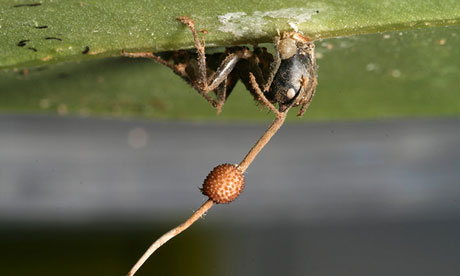O. unilateralis is a parasitic fungus known to manipulate the brains of insects, ants in particular, as it makes an ant decimate the entirety of its own colony. It makes slave-like "zombies" out of its host by recognizing the brains of the different insect species, and in reaction to their species, releases its mind-controlling chemical cocktail into the host's system that eventually travels to its brain. "Behavioral manipulation is such a complex [characteristic] that it only occurs when there's a very close co-evolution between pathogen and host," said Charissa de Bekker, a molecular biologist at Pennsylvania State University and lead author in the journal BMC Evolutionary Biology.
Here is a video link of the fungi affecting an ant in action.
Once an insect walks through some of its fungal spores, the fungus bores its way into the insect's body and eventually takes over its nervous system and its brain. In ants in particular, he fungus makes the ant climb up a nearby plant stalk bite into a leaf nearest to its former colony. The ant soon dies and a long, mushroom stalk breaks through its skull and grows from out of the back of its head, which then releases fungal spores into the air so that they will float down on to the colony below to infect the rest of the colony.
Here's an image of a worker ant that was infected and climbed to a leaf above its colony and sprouted spores. Sorry if your're squeamish to these kinds of things, I am too: I nearly threw up just finding this picture on google images. This is one of the less horrifying-looking ones.
‘What’s rather spectacular in the case of the zombie ant
fungi is that they are able to precisely control the behavior of the host
before it dies,’ said disease biologist David Hughes, assistant professor of
entomology and biology at Pennsylvania State University, who has followed these
intriguing organisms all around the world. They can be found in many forests of
several countries, such as Thailand, China, Australia and Brazil.
He described
what happens when a spore first attaches itself to an insect on the forest floor. “It
does a rather interesting thing – it sticks tight so it can’t be pulled off and
then it uses enzymes and pressure to blow a hole through the insect’s body.”
After two weeks growing inside the insect, the fungus is able
to control its behavior and produces chemicals that make the ant to go through
the process to infect its colony. Dr Hughes is currently preparing a report
which identifies how exactly these chemicals work. ‘It’s one of the most
complex examples of parasites controlling animal behaviour that we know about.
The Last of Us, developed by Naughty Dog and exclusively
available on the PlayStation 3 and Playstation 4 console systems, takes the Cordyceps concept (the infecred
“zombies” of the game”) and pushes it to its limit. The game is set 20 years
after a fungal parasite mutated to infect mammals and had taken out most of humanity. Players take
the role of survivors battling to survive in a world of grotesque,
fungus-faced creatures that are driven by this parasite to infect as many as it
can.
Dr Hughes pointed out that fungi are more closely related to
animals than they are to plants. He also worked as a consultant to the
game-makers.
‘They gravitated towards the idea of growth and they liked
the grossness of it,’ he revealed.
Suddenly the walking dead walkers aren't all that scary to me after looking at these monstrosities Naughty Dog's talented game artists designed. Now if you'll excuse me I need to work on my Bubble-Boy style anti-spore suit because mushroom spores are airborne and I am not gonna turn into that thing.
But the big question is, could a parasitic fungal pandemic as
depicted in The Last of Us really happen?
“It’s a flight of fancy to think one of those parasites will
be a specialized fungus that only affects ant behavior but the history of
medicine shows us that there’s lots and lots of parasites jumping over from
animals into humans and then having crazy effects,” said Dr Hughes.
“We constantly inhale billions of spores of fungi every day
and our immune system is very well set up to prevent these infections. And we
do occasionally see fungi jumping the species barrier, going from one animal
into humans.”
He said Aids sufferers in South East Asia have died from
fungal infections contracted from small mammals.
In parts of the US, the fungal disease coccidiodomycosis –
or Valley Fever – kills hundreds of people a year after it is contracted from
spores swept into the air from soil.
“It’s foolish to to think we’re living in a sanitised world
protected from mass outbreaks,” said Dr Hughes, before listing examples such as
influenza, bird flu, and SARS.
So is it? That's more up to you to decide based on the evidence I can provide.




